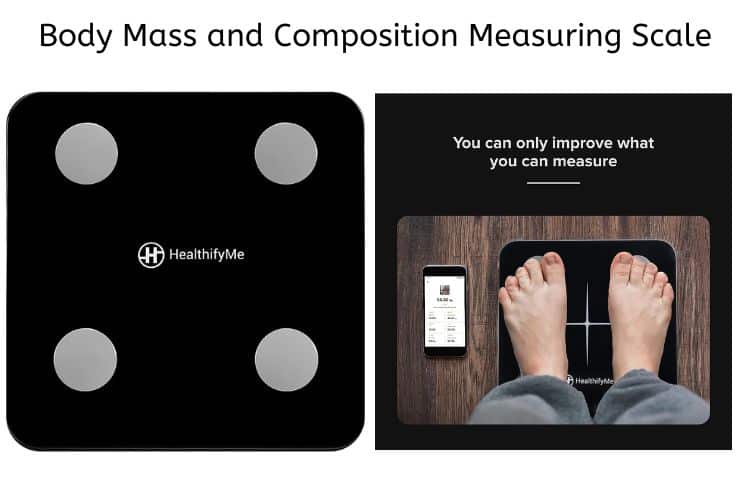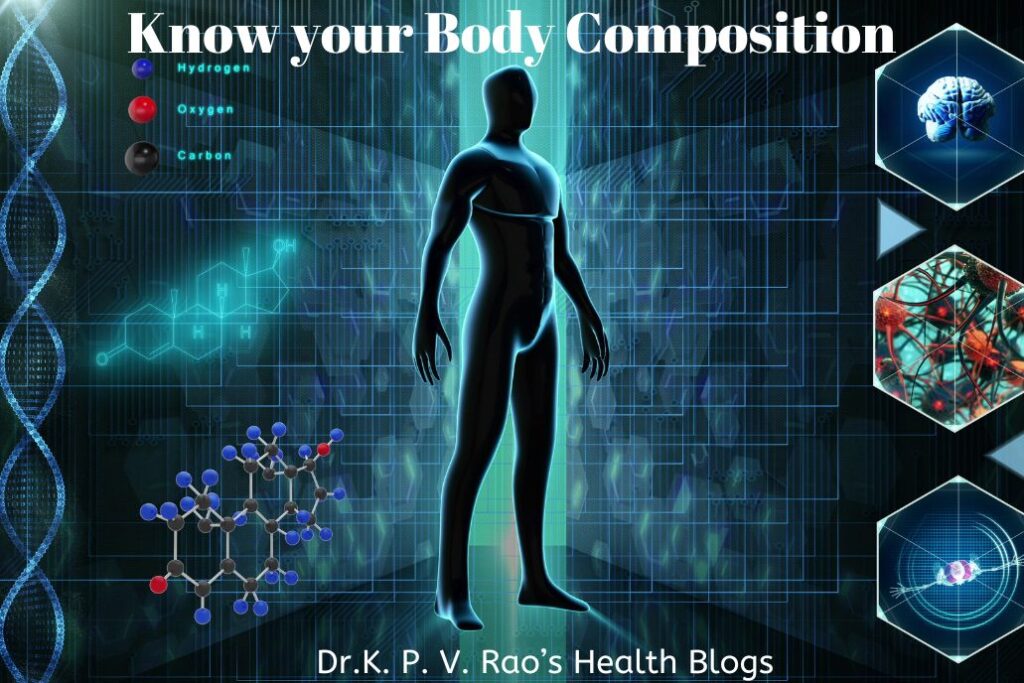Table of Contents
Introduction to Body Mass Composition
In my medical practice, I come across many patients—some are skinny, some are overweight, and some are grossly overweight or obese.

In the past, I have written a few articles on how to overcome obesity. You can read one of them here:
But did you know that all these conditions mentioned above depend on our overall body composition? If not, let’s learn today what I mean by your body composition and how it shapes our body as well as our overall health.
In the pursuit of achieving our weight goals, understanding body composition plays a significant role. It’s not just about the number on the scale; it’s about what makes up that number.
Dr. K. P. V. Rao’s Health Blogs
Body composition encompasses various factors such as total body fat percentage, muscle mass, and bone mass, all of which impact our overall weight and shape.
The importance of understanding body composition
Having a clear understanding of these components can help us design a more effective and sustainable weight loss or fitness plan.
For instance, total body fat percentage indicates the proportion of fat in our bodies and is a better indicator of health than just weight alone.
On the other hand, muscle mass plays a crucial role in boosting our metabolism and aiding in weight loss.
Total body fat percentage: What it is and why it matters
Total body fat percentage refers to the amount of fat present in our body relative to our total weight. This measurement takes into account both essential fat, which is necessary for normal bodily functions, and non-essential fat, which is stored for energy reserves.
Understanding our total body fat percentage is important because it provides a more accurate reflection of our overall health and fitness level compared to just relying on weight alone.
A healthy body fat percentage for men is between 10 to 20%, and for women, it’s between 20 to 30%.
Knowing our total body fat percentage allows us to set realistic weight goals and make more informed decisions about our dietary choices and exercise routines.
For example, individuals with a higher total body fat percentage may need to focus on reducing fat mass through a combination of diet and exercise, while those with a lower total body fat percentage may need to prioritize muscle building and toning.
Knowing Subcutaneous Fat Percentage and Visceral Fat Percentage
When considering total body fat percentage, it’s important to understand the distribution of fat within our bodies.
Subcutaneous fat is the fat stored just beneath the skin, while visceral fat is the fat stored around our viscera (our organs).
Both types of fat can contribute to overall body fat percentage, but visceral fat is considered more dangerous as it is associated with increased health risks such as heart disease and diabetes.
Measuring subcutaneous fat percentage and visceral fat percentage can provide valuable insights into our overall health and help guide our weight goals.
For example, individuals with a higher percentage of visceral fat may need to focus on reducing this type of fat through targeted exercise and dietary modifications, as it poses a greater risk to their health.
For visceral fat, a rating of 1 to 12 is considered healthy. Anything above 12 indicates a high level of visceral fat, which poses a risk to health. Minus this from your total body fat percentage gives you your subcutaneous fats percentage. This is the fat that comes under your fingers when you picnch your skin [have a look at the image below]:

To know more about these two types of fats, read this article-
Muscle mass: The role it plays in body composition and weight goals
Muscle mass refers to the amount of muscle tissue in our bodies. It is a crucial component of body composition as it not only contributes to overall weight but also plays a significant role in metabolism and weight management. Unlike fat, which is relatively inactive, muscle tissue is metabolically active and burns more calories at rest.
Having a higher muscle mass can increase our basal metabolic rate (BMR), which is the number of calories our bodies burn at rest. For more on BMR and muscle mass, you can refer to this short article:
This means that individuals with a higher muscle mass can consume more calories without gaining weight compared to those with a lower muscle mass.
Additionally, building and maintaining muscle mass can help improve body shape and increase overall strength and endurance.
Bone mass: Understanding its impact on overall body composition
Bone mass refers to the amount of bone tissue in our bodies. While it may not directly impact weight goals, it is an essential component of body composition and overall health.
Adequate bone mass is crucial for maintaining proper bone density and strength, reducing the risk of osteoporosis and fractures.
Bone mass can vary depending on factors such as
- age,
- gender, and
- lifestyle.
Individuals with low bone mass may need to focus on incorporating weight-bearing exercises and consuming foods rich in calcium and vitamin D to support bone health.
Measuring body composition: Methods and tools
There are several methods and tools available to measure body composition accurately. Some common techniques include:
- Dual-Energy X-ray Absorptiometry (DEXA) scans,
- Bioelectrical impedance analysis (BIA),
- Skinfold calipers, and
- Air displacement plethysmography (ADP)
Each method has its advantages and limitations, and the choice of measurement technique depends on factors such as accessibility, cost, and accuracy.
I personally use a Smart Scale (picture shown below) to keep track of my body composition changes-

It’s important to note that these measurements provide a snapshot of our body composition at a specific point in time and may fluctuate based on various factors, such as hydration levels and recent physical activity. Therefore, it’s advisable to track changes in body composition over time rather than relying solely on a single measurement.
For more on this topic, read this:
Interpreting body composition results: What the numbers mean
Understanding how to interpret body composition results is essential in assessing our progress towards our weight goals.
When receiving body composition analysis, we typically receive a breakdown of total body fat percentage, muscle mass, and bone mass. These results can be compared to population averages or age and gender-specific norms to determine whether our body composition falls within a healthy range.
Interpreting body composition results goes beyond just looking at the numbers. It’s essential to consider factors such as overall health, fitness level, and individual goals.
Consulting with a healthcare professional or a registered dietitian can provide valuable guidance in understanding our body composition results and setting realistic weight goals.
Setting realistic weight goals based on body composition
Setting realistic weight goals based on body composition involves considering various factors such as total body fat percentage, muscle mass, and bone mass.
It’s important to focus on achieving a healthy body composition rather than solely aiming for a specific number on the scale. This means striking a balance between reducing excess body fat while maintaining or building muscle mass and supporting bone health.
Rather than aiming for rapid weight loss, which often leads to muscle loss and a rebound in weight gain, it’s advisable to focus on steady and sustainable progress.
This can be achieved through a combination of regular exercise, a balanced and nutritious diet, and lifestyle adjustments that promote overall health and well-being.
Strategies for improving body composition and achieving weight goals
Improving body composition and achieving weight goals require a multifaceted approach that addresses both diet and exercise. Here are some strategies to consider:
- Resistance training: Incorporate strength training exercises at least two to three times a week to build and maintain muscle mass.
- Cardiovascular exercise: Engage in aerobic activities such as running, cycling, or swimming to burn calories and support overall health.
- Protein intake: Consume an adequate amount of protein to support muscle growth and repair.
- Caloric balance: Create a moderate calorie deficit through a combination of diet and exercise to promote gradual and sustainable weight loss.
- Nutrient-dense diet: Focus on whole, unprocessed foods that provide essential nutrients while limiting excessive intake of refined sugars and unhealthy fats.
- Hydration: Stay well-hydrated to support overall health and proper bodily functions.
- Rest and recovery: Allow for adequate rest and recovery periods to optimize muscle growth and prevent injury.
Conclusion: Embracing a holistic approach to weight management
In conclusion, understanding body composition is vital in our journey towards achieving our weight goals. Total body fat percentage, muscle mass, and bone mass all play significant roles in our overall weight and shape.
By delving deeper into body composition and considering factors beyond just weight, we can make informed decisions about our dietary choices, exercise routines, and lifestyle adjustments.
Instead of solely focusing on losing weight quickly, it’s important to prioritize a holistic approach that promotes sustainable progress and overall health.
By setting realistic weight goals based on body composition and incorporating strategies such as resistance training, cardiovascular exercise, and a nutrient-dense diet, we can improve our body composition and achieve long-term success in managing our weight.
Final words
I hope you enjoyed reading this article. If yes, please share it with your friends and family members using the social media icons at the bottom of this article. Alternately, if you have X account, you can Click to Tweet here:
Know your Body Composition: Body Fat Percentage, Muscle Mass and Bone mass Share on XMy next article will be on a serious eye condition called Glaucoma- a disease that can lead to blindness if not treated on time.
